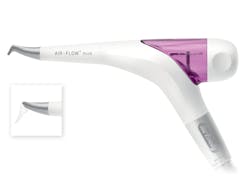Air polishing: Have I been doing it wrong?
Sponsored article
As a hygienist, do you avoid using air polishing in your practice? You may have preconceived notions about how it works and what it can and cannot do. Like most hygienists, your initial introduction to air polishing, likely in school, left you feeling more disappointed than impressed. The early-to-market products were too messy and too harsh, giving you no reason to use air polishing over traditional scaling and rubber cup polishing methods.
AIRFLOW® Therapy changes all that. This system is more advanced than any air polishing product you’ve tried in the past. Incorporating AIRFLOW Therapy into your practice will improve how you handle biofilm management, saving you time and leading to healthier, happier patients. With AIRFLOW Therapy, there are no worries about messy procedures or patient discomfort. This system actually reduces the amount of time it takes to remove biofilm, making your practice more efficient and profitable while also allowing you to provide your patients with optimal care.
Air polishing technology has changed, and with proper training and manufacturer support, you can easily incorporate this biofilm management method into your workflow. Hu-Friedy offers the support you need to make it happen, along with an advanced air polishing solution that’s unlike any other system on the market.
Still not convinced you should incorporate air polishing into your practice? Here are the top concerns hygienists have about air polishing and how AIRFLOW Therapy addresses each one. You’ll find air polishing technology deserves a second look, and that it’s come a long way from what you remember.
Concern 1: Powder is a problem
What makes AIRFLOW’s powders so much better than other options on the market? They’re made with smaller microns and are efficient and effective. AIRFLOW’s PLUS Powder, for example, is made with erythritol, a sugar alcohol with a grain size of just 14 microns. It’s unique particle shape and strength are great for biofilm removal and light to moderate stain removal. Another low abrasive option is PERIO Powder, made with glycine, an amino acid with proven effectiveness for biofilm and light stain removal. Finally, for patients with heavier stain, AIRFLOW Classic powder is a more comfortable sodium bicarbonate option with a grain size of 40 microns.
Concern 2: Patient comfort
Another concern about air polishing is patient discomfort. The devices are optimized for low abrasive powders to deliver a gentle spray that can be directed toward the gingiva, minimizing the messiness for the patient. Using AIRFLOW for biofilm removal reduces the amount of instrumentation overall, leaving hand and ultrasonic scalers for hard deposits. Biofilm removal in periodontal pockets is made easier with the PERIOFLOW®nozzle—a flexible plastic nozzle that inserts into the pocket to disrupt the biofilm. Compared to metal subgingival tips, the PERIOFlOW nozzle is easier to fit around crown contours, particularly implant prosthetics.
AIRFLOW therapy improves biofilm management within your hygiene appointments. Patients will notice the comfort and efficiency, leaving your office with that “just cleaned” feeling everyone loves.
Concern 3: It doesn’t fit my workflow
- Screening/exam diagnosis
- AIRFLOW Therapy for biofilm removal
- Scaling for calculus removal
- Patient education and extra services
Why does AIRFLOW Therapy come before scaling? Finishing biofilm removal before calculus removal reduces instrumentation time and clears the surfaces to better detect hard deposits. The time-consuming “stroke-by-stroke” biofilm removal you’ve gotten used to isn’t necessary anymore. This gives you extra time to focus on other tasks that bring value to your practice, such as talking to patients about the various services you provide and how those services can help them meet their oral health goals.
AIRFLOW systems come in different options, from a versatile table top unit to a basic device that connects to the hand piece hose. They are designed with ergonomics in mind, making them easy to incorporate into any practice.
Add efficiency and value to your practice with air polishing
So, have you been doing it wrong? No! The timing just wasn’t right. Earlier air polishing products weren’t nearly as effective as AIRFLOW and came with gritty, harsh powders that led to discomfort for patients and did nothing to improve efficiencies or add value to your practice. No wonder you didn’t want to use them. But the advanced AIRFLOW Therapy systems are different. They’re designed with patient comfort in mind and bring time-savings you can turn into value in other areas of the practice.
With AIRFLOW therapy, patients receive better care in less time. You can easily remove biofilm, supra and subgingivally, and around implants, enhancing patient health and making the patient experience more pleasant. This advanced system addresses any concerns you’ve ever had about air polishing and is easy to incorporate into your routine. AIRFLOW Therapy changes the game, giving you an option that’s more effective than traditional methods, leading to enhanced efficiencies and happier patients who stay loyal to your practice.



